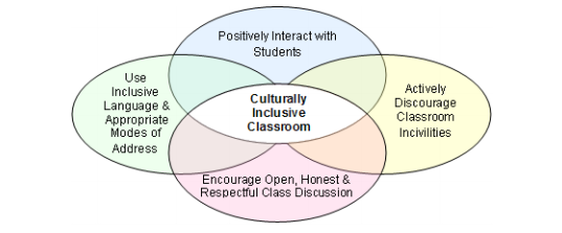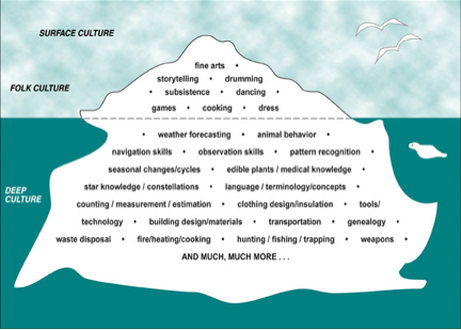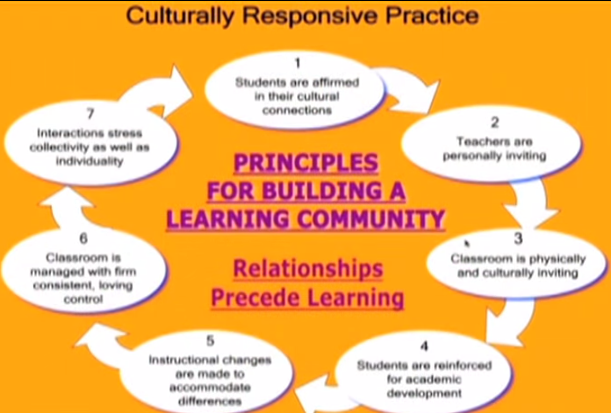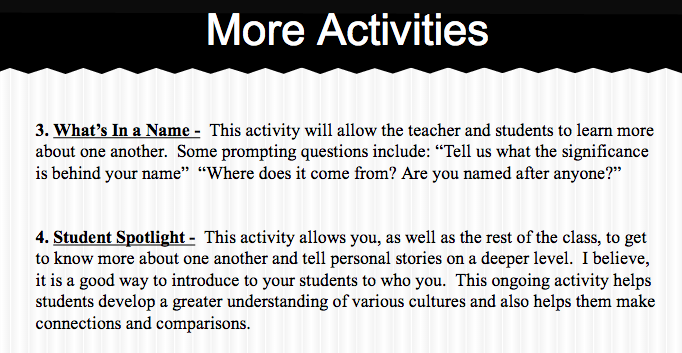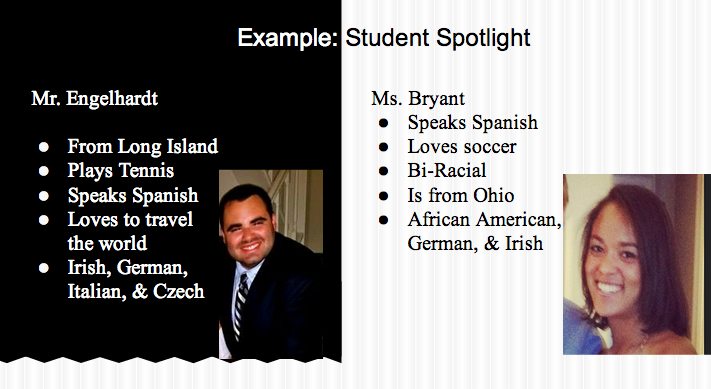Culturally Inclusive,
Culturally Responsive
Culturally Inclusive classroom:
defined

"A culturally inclusive classroom is one where students and staff alike recognize, appreciate and capitalize on diversity so as to enrich the overall learning experience. Fostering a culturally inclusive learning environment encourages all individuals – regardless of age, gender, ethnicity, religious affiliation, socioeconomic status, sexual orientation or political beliefs – to develop personal contacts and effective intercultural skills." -- Barker et al.
"Teachers are cultural translators, cultural Bridge makers."
--Jacqueline Jordan Irvine
Two definitions, given to us by Gary R. Howard in the video below, that I find relevant when discussing culturally inclusive pedagogy include:
Cultural competence - "The will and the ability to form: authentic and effective relationships across differences."
Culturally responsive teaching - "Teaching and leading in such a way that more of your students, across more of their differencing, achieve at a high level and engage at a deeper level, more of the time, WITHOUT giving up who they are."
The 7 principles of Culturally Responsive Teaching - Model by Gary R. Howard:
Cultural competence - "The will and the ability to form: authentic and effective relationships across differences."
Culturally responsive teaching - "Teaching and leading in such a way that more of your students, across more of their differencing, achieve at a high level and engage at a deeper level, more of the time, WITHOUT giving up who they are."
The 7 principles of Culturally Responsive Teaching - Model by Gary R. Howard:
- 1) Students are affirmed in their cultural connections
- 2) Teachers are personally inviting
- 3) The classroom is physically and culturally inviting
- 4) Students are reinforced for academic development
- 5) Instructional changes are made to accommodate differences
- 6) The classroom is managed with a firm, consistent, loving control
- 7) Interactions stress collectivity as well as individuality
"The cultural competence of the adults is intimately connected to the achievement of students." |
I believe the quote to the left in green, reflects an important truth that lies at the center of what culturally response teaching is. One thing that many teachers often forget, is how perceptive our students are; they can pick up on the slightest hint of anger, disgust, and insincerity. Being human, even though the tasks we get our students to perform and succeed seem super human, we make mistakes, and our our biases and perceptions may creep into our interactions with students. As teachers, we must do our best to rid ourselves of these biases and can do that by experiencing and learning about other cultures first hand. How can we expect students to be culturally responsive and welcoming, if we ourselves are not? As teachers, we must model cultural tolerance and acceptance of all.
|
"CULTURALLY RESPONSIVE PEDAGOGY BUILDS ON STUDENTS' PRIOR KNOWLEDGE...Making connections between what is known and what is to be taught and understood." --JACQUELINE JORDAN IRVINE
I discovered this TED Talk, titled, "Confessions: New Teacher of Newcomers" delivered by veteran teacher, Michelle Benegas, while conducting a search on culturally inclusive teaching,. In this TED Talk, Benegas recounts her time as a new teacher in an extremely diverse school setting and not having the proper pedagogical tools and cultural knowledge to best serve her students. I truly believe that the specific examples she provides her audience, re-tell the story of pain she feels now, about being unable to help her students when they were younger. It is an inspiring video that will help teachers alike understand why getting to know your students and their respective cultures will make all the difference. It also shows the value of teaching cultural inclusive pedagogy in today's teacher education programs.
With that being said, teachers need to help students realize that they are unique, valued, and bring different skill sets that they can offer to the class, school, and communities they are a part of. I believe it is valuable for teachers to understand the different capitals that exist at school. These four different types of capital, As Zwiers explains in chapter one, "Understanding How Students Use Language", are unequally distributed, just as money is (7). He goes on to explain that the four types of capital overlap one another and their levels or potency vary from student to student. These four capitals are, social, cultural, knowledge, and linguistic capitals.
As Dr. Zisselsberger explained in class, these capitals, should be viewed as notions of continuums, that are not static and change from environment to environment. She explained that students can gain and loose capital in each of the four different types as students grow and learn. Dr Zisselsberger also mentioned to the class that the "levels" of capital of each student is dependent upon the a student's background and what they bring to the classroom.
Social Capital
To begin, social capital, "consists of the amounts and qualities of: (1) interactions with adults, siblings, and peers, (2) listening abilities, (3) empathy skills, and (4) appropriate behaviors and responses (Zwiers, 7)". To me, social capital deals with the amount of social interaction a student has with a wide variety of people and how a student interacts, relates, and responds with different people. At school, students will come across a variety of situations in which they will need interact with people varying in age and backgrounds. I believe that social capital is the most valued by students, especially those in middle and high school; they do not want to be an outcast or viewed differently and truly want to have friends and fit in.
Cultural Capital
Zwiers states that cultural capital "tends to consist of travel experiences, wealth, parent education, music listened to, games at home, being read to, reading, race, and religion related experience (Zwiers, 7)". For me, cultural capital reflects more of the student's up-brining and life experiences outside of the classroom and school.
Knowledge Capital
According to Zwiers, knowledge capital, "tends to develop (accumulate) from reading, being read to, watching educational and new programs on TV, using computers, organizational abilities with knowledge, word memory abilities, travel, conversations with siblings and adults, and parents asking and answering questions about the world (Zwiers, 7)". For me knowledge capital is rooted in the ability to read and access information whether it be from books or on a computer. I agreed with Dr. Zisselsberger when she stated in the classroom, knowledge capital is most likely the most valued of the capitals.
Linguistic Capital
The fourth type of capital is linguistic. Zwiers states, "Linguistic capital consists of the quantity and quality of language used by parents and peers, in TV shows, and in daily discussions; of religious interactions, which can develop, abilities to use abstract language; of computer experiences and games; and of books at home, whether one is reading [to] oneself or being read to (Zwiers, 7)". For me, linguistic capital deals with the amount and quality of "language" input a student receives. I also believe it has a lot to do with a student's cultural and socioeconomic background.
As Dr. Zisselsberger explained in class, these capitals, should be viewed as notions of continuums, that are not static and change from environment to environment. She explained that students can gain and loose capital in each of the four different types as students grow and learn. Dr Zisselsberger also mentioned to the class that the "levels" of capital of each student is dependent upon the a student's background and what they bring to the classroom.
Social Capital
To begin, social capital, "consists of the amounts and qualities of: (1) interactions with adults, siblings, and peers, (2) listening abilities, (3) empathy skills, and (4) appropriate behaviors and responses (Zwiers, 7)". To me, social capital deals with the amount of social interaction a student has with a wide variety of people and how a student interacts, relates, and responds with different people. At school, students will come across a variety of situations in which they will need interact with people varying in age and backgrounds. I believe that social capital is the most valued by students, especially those in middle and high school; they do not want to be an outcast or viewed differently and truly want to have friends and fit in.
Cultural Capital
Zwiers states that cultural capital "tends to consist of travel experiences, wealth, parent education, music listened to, games at home, being read to, reading, race, and religion related experience (Zwiers, 7)". For me, cultural capital reflects more of the student's up-brining and life experiences outside of the classroom and school.
Knowledge Capital
According to Zwiers, knowledge capital, "tends to develop (accumulate) from reading, being read to, watching educational and new programs on TV, using computers, organizational abilities with knowledge, word memory abilities, travel, conversations with siblings and adults, and parents asking and answering questions about the world (Zwiers, 7)". For me knowledge capital is rooted in the ability to read and access information whether it be from books or on a computer. I agreed with Dr. Zisselsberger when she stated in the classroom, knowledge capital is most likely the most valued of the capitals.
Linguistic Capital
The fourth type of capital is linguistic. Zwiers states, "Linguistic capital consists of the quantity and quality of language used by parents and peers, in TV shows, and in daily discussions; of religious interactions, which can develop, abilities to use abstract language; of computer experiences and games; and of books at home, whether one is reading [to] oneself or being read to (Zwiers, 7)". For me, linguistic capital deals with the amount and quality of "language" input a student receives. I also believe it has a lot to do with a student's cultural and socioeconomic background.
This is one of my favorite educational videos that I have ever encountered. The video itself focuses in on the self-esteem of students with disabilities, but at the same time, the context of the video could easily be switched to discuss linguistically and culturally diverse students. I am NOT, by any means comparing the state or abilities of linguistically and culturally diverse students to those of students with disabilities; I want to emphasize, that just as students with disabilities, culturally and linguistically diverse students lack "the poker chips" to engage in and play in the game we call school.
To show you how this is applicable to the diverse learners we will encounter in our classrooms, let's examine the case of Sandra. To begin, these "poker chips" are representative of the various capitals that students bring with them into the classroom. For example, Sandra, from Colombia may have 1000 cultural capital poker chips because she comes from a very close knit, supportive family, that exposed her to many elements of culture, read to her when she was little, and raised her to be a devout Catholic. On the other end of the spectrum, she may have 15 linguistic capital poker chips because the only English that she hears at home comes from the television, which she is only allowed to watch after finishing her homework and chores. Sandra will be less likely to interact within the classroom, because she does not have enough linguistic chips to gamble away, meaning take a chance on making a mistake or getting made fun of in front of the entire class. If she does take that chance and gets the answer right, yes, she will increase the amount of linguistic poker chips she has, boosting her self-esteem, but in the back of her mind always looms the "what if scenario".
As a culturally responsive teachers, it is our job to encourage the student and make them feel included by incorporating familiar elements into the classroom. The first step that a culturally responsive teacher must take, is to do their homework. How do you expect to meaningful engage, connect, and interact with students, if you do not know anything about their home life, culture, and what prior knowledge and experiences they bring into the classroom? A teacher must lay the ground work and foster a warm, inviting, and safe, classroom culture in which students feel appreciated, valued, and will want to share personal information pertaining to the class and content area. I believe that all of these elements truly stem from the way in which a teacher is able to connect with his or her students, and creating a relationship in which the students feel that the teacher cares about them, sees them for a human being, and believes that they can succeed .
To show you how this is applicable to the diverse learners we will encounter in our classrooms, let's examine the case of Sandra. To begin, these "poker chips" are representative of the various capitals that students bring with them into the classroom. For example, Sandra, from Colombia may have 1000 cultural capital poker chips because she comes from a very close knit, supportive family, that exposed her to many elements of culture, read to her when she was little, and raised her to be a devout Catholic. On the other end of the spectrum, she may have 15 linguistic capital poker chips because the only English that she hears at home comes from the television, which she is only allowed to watch after finishing her homework and chores. Sandra will be less likely to interact within the classroom, because she does not have enough linguistic chips to gamble away, meaning take a chance on making a mistake or getting made fun of in front of the entire class. If she does take that chance and gets the answer right, yes, she will increase the amount of linguistic poker chips she has, boosting her self-esteem, but in the back of her mind always looms the "what if scenario".
As a culturally responsive teachers, it is our job to encourage the student and make them feel included by incorporating familiar elements into the classroom. The first step that a culturally responsive teacher must take, is to do their homework. How do you expect to meaningful engage, connect, and interact with students, if you do not know anything about their home life, culture, and what prior knowledge and experiences they bring into the classroom? A teacher must lay the ground work and foster a warm, inviting, and safe, classroom culture in which students feel appreciated, valued, and will want to share personal information pertaining to the class and content area. I believe that all of these elements truly stem from the way in which a teacher is able to connect with his or her students, and creating a relationship in which the students feel that the teacher cares about them, sees them for a human being, and believes that they can succeed .
Strategies for Success
How can you teach inclusively?
1. Be reflective by asking yourself the following
a. How might your own cultural-bound assumptions influence your interactions with students?
b. How might the backgrounds and experiences of your students influence their motivation, engagement, and learning in your classroom?
c. How can you modify course materials, activities, assignments, and/or exams to be more accessible to all students in your class?
2. Incorporate diversity into your overall curriculum.
3. Be intentional about creating a safe learning environment by utilizing ground rules.
4. Be proactive in connecting with and learning about your students.
5. Utilize a variety of teaching strategies, activities, and assignments that will accommodate the needs of students with diverse learning styles, abilities, backgrounds, and experiences.
6. Use universal design principles to create accessible classes. For example, present information both orally and visually to accommodate both students with visual or auditory impairments in addition to students with various learning preferences.
7. When possible, provide flexibility in how students demonstrate their knowledge and how you assess student knowledge and development. Vary your assessments (for example, incorporate a blend of collaborative and individual assignments) or allow choice in assignments (for example, give students multiple project topics to choose from, or have students determine the weight of each assignment on their final grade at the beginning of the semester.)
8. Be clear about how students will be evaluated and graded. Provide justifications.
9. Take time to assess the classroom climate by obtaining mid-semester feedback from students.
a. Pass out index cards during class for anonymous feedback.
b. Ask students to rate from 1-5 how comfortable they are in class. Also ask for 2 suggestions for how they could feel more comfortable.
c. Conduct a Qualtrics survey.
d. Discuss your findings in the next class and share any changes you will make regarding the feedback.
Strategies Provided by the Cornell University: Center for Teaching Excellence (http://www.cte.cornell.edu/teaching-ideas/building-inclusive-classrooms/inclusive-teaching-strategies.html)
1. Be reflective by asking yourself the following
a. How might your own cultural-bound assumptions influence your interactions with students?
b. How might the backgrounds and experiences of your students influence their motivation, engagement, and learning in your classroom?
c. How can you modify course materials, activities, assignments, and/or exams to be more accessible to all students in your class?
2. Incorporate diversity into your overall curriculum.
3. Be intentional about creating a safe learning environment by utilizing ground rules.
4. Be proactive in connecting with and learning about your students.
5. Utilize a variety of teaching strategies, activities, and assignments that will accommodate the needs of students with diverse learning styles, abilities, backgrounds, and experiences.
6. Use universal design principles to create accessible classes. For example, present information both orally and visually to accommodate both students with visual or auditory impairments in addition to students with various learning preferences.
7. When possible, provide flexibility in how students demonstrate their knowledge and how you assess student knowledge and development. Vary your assessments (for example, incorporate a blend of collaborative and individual assignments) or allow choice in assignments (for example, give students multiple project topics to choose from, or have students determine the weight of each assignment on their final grade at the beginning of the semester.)
8. Be clear about how students will be evaluated and graded. Provide justifications.
9. Take time to assess the classroom climate by obtaining mid-semester feedback from students.
a. Pass out index cards during class for anonymous feedback.
b. Ask students to rate from 1-5 how comfortable they are in class. Also ask for 2 suggestions for how they could feel more comfortable.
c. Conduct a Qualtrics survey.
d. Discuss your findings in the next class and share any changes you will make regarding the feedback.
Strategies Provided by the Cornell University: Center for Teaching Excellence (http://www.cte.cornell.edu/teaching-ideas/building-inclusive-classrooms/inclusive-teaching-strategies.html)
I believe this video offers teachers a quick and explicit outline of how to create a culturally inclusive classroom from top to bottom, beginning with addressing your own ideas, biases, and stereotypes. Once you are able to overcome, what I like to consider " self-road-blocks" to creating a culturally inclusive environment, you can tackle other elements and help your students appreciate and look forward to learning about one another the unique background that everyone brings into the classroom.
Examples of Culturally Responsive Teaching Activities for all cotent areas
Below, I have posted three slides providing activities, I believe will help you as a teacher get to know your students an have them interact with one another in a more meaningful context.
